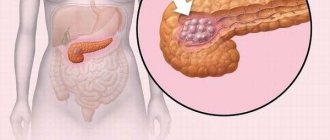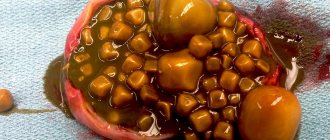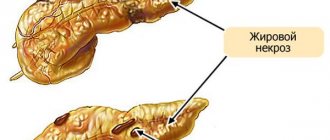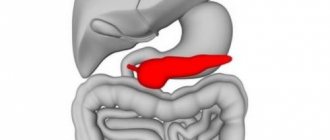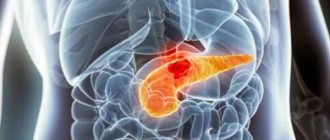Stones in the pancreas are a complication of chronic pancreatitis. In medicine it is called pancreolithiasis.
The disease is diagnosed according to various sources in 25-60% of patients with pancreatitis. The main digestive function of the pancreas is to produce pancreatic juice to digest and absorb food. The juice flows down the gland channel into the small intestine. In a healthy person, this canal is smooth and even, but in a patient with chronic pancreatitis, due to prolonged inflammation, scars form in the canal, narrowing it.
Because of this, pancreatic juice does not flow out well, stones appear in the duct, blocking the channel and causing severe pain.
What it is?
The composition of the formations includes chemical components: calcium salts - calcium orthophosphate and calcium carbonate, admixtures of aluminum and magnesium salts. They contain organic substances - cholesterol, protein elements, particles of epithelial membranes and leukocytes. The color of pancreatic calcifications is white or with a yellowish tint.
Stones in the pancreatic ducts vary in size and shape, and can be single or multiple. Large single stones are often located in the head of the pancreas, small multiple ones - in the tail and small ducts. The parenchyma of the pancreas also undergoes calcification.
Diseases of the pancreas are directly related to pathologies in the biliary system and gall bladder. The composition of gallstones and the mechanism of formation differ from pancreatic calcifications. Gallstones are formed as a result of dysfunction of the liver and gallbladder, excess cholesterol in the body and lack of bile acids.
The composition of gallstones and the structure of formations depend on the causes of their appearance, conditions of growth and development.
More details about the problem
Stones in the pancreas can have different sizes and shapes. In most cases, such formations are oval, but irregularly shaped calcifications are also common. Most often, such stones form in accessory ducts or in their branches. On the other hand, the formation of solid structures can also be observed in the parenchyma of the pancreas itself.
As for the chemical composition, the main stones of such stones are phosphate or calcium carbonate salts. In addition, such formations may contain compounds of aluminum, magnesium, as well as some substances of organic origin.
Causes of stone formation
In order for stones to begin to form in the pancreas, several provoking factors must come together at once:
- Congestion resulting from tumors, cysts or common bile duct stones (this causes thickening of pancreatic secretions and precipitation of protein fractions);
- Disruption of hormonal and ion exchanges, as a result of which the chemical composition of pancreatic juice changes;
- Soaking the protein mass with calcium salts;
- The presence of inflammatory processes of the duodenum, pancreas and biliary tract.
It is worth noting that stones form both in the pancreatic duct and in its parenchyma. Along with their increase in size, the passage of pancreatic juice through the duct of the pancreas worsens and its stagnation worsens. As a result of ever-increasing pressure, the ducts begin to stretch and expand. Dead areas form in the tissues of the pancreas, which become calcified over time. Damage occurs both in the exocrine pancreas and in the islet tissues.
Insulin production decreases, the pancreas begins to produce less and less enzymes. And if the stones formed long enough, this can lead to the development of symptomatic diabetes mellitus, or secondary forms of this disease.
Folk remedies for stones in the pancreas
For this disease, along with traditional medicine, traditional methods of treatment in the form of decoctions of medicinal plants are widely used. As a rule, treatment of the pancreas with herbs consists of relieving inflammation in the organ, as well as dissolving and removing sand from the pancreatic ducts.
For these purposes, an infusion of burdock roots is used, as well as collections of medicinal plants: linden, chamomile, St. John's wort, mint. A cocktail proposed by Professor S. A. Arakelyan, which consists of lemon juice, honey and mint tincture, also helps cleanse the gland ducts and dissolve stones.
It should be remembered that self-medication in this case can be harmful to health. Before using any pancreatic treatment, consult your doctor.
Symptoms
The severity of symptoms depends on the stage of development and localization of the stones - they can be located in the ducts or the parenchymatous layer of the gland. In all cases, the main sign of stone formation is pain. Pain from pancreolithiasis can last from several minutes to several hours. The nature of the pain is burning, in the form of colic, covering the abdomen and lower back, radiating to the shoulder blade. Attacks can be daily or occur rarely, several times a month or even a year.
Other symptoms of stone formation:
- increased pain during eating and palpation;
- attacks of nausea and vomiting of bile;
- lightening of the stool and the presence of undigested fat in it (steatorrhea - fatty stool);
- excessive salivation;
- the stomach looks bloated;
- general malaise, sweating.
With a long course of pancreolithiasis, against the background of a decrease in pancreatic secretory function, insulin production decreases. Along with the typical signs, symptoms of diabetes mellitus appear - dry skin, irresistible thirst, polyuria, the smell of acetone from the mouth. Migration of stone from the pancreas to the bile duct causes the development of obstructive jaundice.
Complications of pancreolithiasis are dangerous. If a stone clogs the ducts for a long period, acute pancreatitis develops with infection of the gland tissue. Often, purulent abscesses and cysts appear against the background of stones. In the presence of large stones, there is a high risk of hemorrhage into the duct or parenchyma of the gland with subsequent tissue death.
Diagnostics
In recent years, modern medicine has been able to identify cases of stagnation of stones in the pancreas at an early stage of development and prescribe the necessary treatment. This is due to the development of modern technologies in the medical field. The pancreas can be easily diagnosed and in addition to standard tests (urine and blood), the doctor may prescribe:
- Ultrasound examination (ultrasound makes it possible to deeply discern the structure of the organ and the stones it contains);
- MRI and CT – the ability to determine the condition of the organ and the location of stones;
- X-ray observation of the entire abdominal cavity with the possibility of examination in different cavities;
- To determine the patency of the organ, an endoscopic retrograde cholangiopancreatography procedure is prescribed.
Modern technologies are so developed today that the pancreas can be easily examined and the presence of calcifications and microscopic stones in tissues and ducts, called sand, is detected.
The main causes of deposits
To date, scientists have not yet been able to discover all the possible causes of the development of such a disease. However, some risk factors have already been identified:
- Stones in the pancreas often form against the background of inflammatory diseases, including duodenitis and cholecystitis. In addition, this pathology is often associated with gallstone disease.
- Risk factors also include any pathological processes in the abdominal cavity that can impede the outflow of pancreatic juice, including the presence of cysts, tumors, edema, inflammation, etc.
- Hormonal disorders also play an important role in the development of this disease. In particular, the formation of stones is often associated with disorders of the parathyroid glands, which lead to impaired calcium metabolism in the body.
- Changes in the chemical properties of pancreatic secretions caused by certain infectious diseases. For example, pancreolithiasis often occurs against the background of syphilis.
- Bad habits, including alcohol abuse, smoking, etc.
- Poor nutrition.
Complications
The most common complications of pancreatic stones are:
- chronic pancreatitis;
- inflammatory process in the fatty tissue around the pancreas;
- abscesses and cystic growths of this organ;
- stone strangulation (develops when stones form in the pancreatic ducts);
- bleeding into the lumen of the pancreatic ducts (when stones are localized in the ducts).
Pancreolithiasis can contribute to the occurrence of pancreatic necrosis - necrosis of pancreatic tissue, which can occur due to ingestion of large amounts of food (especially fatty foods) and alcohol.
Operation
Surgery (minimally invasive or abdominal) is indicated when the patient:
- Stones remain in the pancreas for several years and at the same time increase in size;
- Attacks of sharp, excruciating pain appear more and more often;
- Progression of the inflammatory process is observed;
- Signs of exhaustion appeared.
The most popular method for removing stones from the pancreas today is endoscopic retrograde cholangiopancreatography (abbreviated ERCP). Using an endoscope, small stones are removed. For larger formations, the duct is slightly incised, thereby increasing its throughput, and the stones are pushed into the intestine.
The least traumatic is external shock wave lithotripsy (ESWL), in which the stones are crushed into powder and then removed using an endoscope or allowed to pass naturally. Before the manipulation begins, the patient is given general anesthesia (this procedure is accompanied by severe pain) and is turned upside down so that his stomach touches the emitter. This method does not cause any consequences other than hematomas (and even then in isolated cases).
If diffuse calcification of pancreatic tissue is detected, it becomes necessary to perform a total pancreatectomy - complete removal of the affected organ. Due to endocrine and exogenous insufficiency developing after such an operation, the patient will face lifelong insulin therapy and enzyme replacement therapy.
How to get rid of stones?
To remove stones from the pancreas, medications, endoscopic methods and surgery are used.
Regardless of the method chosen, therapy always begins with conservative methods. It happens that these measures are enough for small stones to leave the duct and move into the intestines.
The specialist may prescribe the following treatment plan:
- If the stones are small, then the disease is eliminated with medications. Drugs are used to dissolve formations and improve metabolic processes. Conservative treatment consists of using Henodiol or Ursodiol. They help dissolve bile and remove formations.
- The stones are crushed. This is a gentle technique that is performed on an outpatient basis. The treatment is called extracorporeal shock wave lithotripsy. The procedure is performed under general anesthesia. The doctor determines the location of the stones, and the patient lies down on the emitter with his stomach. Under the influence of shock waves, the stones are crushed within 45 minutes. After this, in a powder state, they are removed from the pancreas independently or with the help of an endoscope.
- Stones can be removed surgically if attacks of pain have been bothering them for a long time, pancreatic function is impaired, the pain syndrome cannot be suppressed by any means, symptoms of an inflammatory process in the organ occur, the patient is exhausted, or drug treatment has not brought any results. During the operation, the integrity of the pancreas is damaged. They can excise part of it or redirect the course of the blocked duct, that is, perform a bypass.
- Carry out non-surgical treatment. The procedure is called endoscopic retrograde cholangiopancreatography. Small formations are removed using an endoscope. If the stones are larger than a centimeter, then the duct is cut slightly and the stone is pushed into the intestines.
After treatment, the patient must adhere to all doctor’s instructions to avoid relapse.
Medications
To eliminate pancreatic stones that are small in size and regular in shape, the following treatment tactics are used:
- Pain relief - Papaverine, Acetaminophen, Baralgin are prescribed, which relieve pain and relieve spasms.
- Elimination of the inflammatory process, swelling of tissues and pancreatic ducts. Ibuprofen and other non-steroidal anti-inflammatory drugs are used.
- Dissolution of stones with drugs - Henodiol, Ursodiol, Ursosan. This method is only effective on small stones.
- Enzyme replacement therapy – compensates for the lack of digestive enzymes; Creon, Pancreatin, Mezim, etc. are prescribed.
- If conservative methods of therapy do not alleviate the patient’s condition, hardware and surgical treatment options are used.
Treatment without surgery
Modern medicine has become able to remove stones from the pancreas without surgery. The choice is increasingly being made in favor of non-invasive or minimally invasive treatment methods. Such procedures are easier to tolerate by patients, do not require a long hospital stay, and eliminate or significantly reduce the risk of postoperative infections and complications.
- Extracorporeal shock wave lipotripsy is a method of using sound waves to fragment and grind stones into a powder consistency. The powder then naturally exits the pancreatic canal. The procedure takes from 30 to 60 minutes and is performed under local anesthesia. Side effects sometimes include abdominal pain and bruising.
- An endoscopic procedure called ERCP. A flexible endoscope is inserted through the patient’s nose or mouth, brought to the gland itself and small stones no more than 5 mm in diameter are removed.
- Laparoscopic method. Several incisions of no more than 1 cm are made on the abdomen, a laparoscope is inserted into one of them, and special manipulators are inserted into the rest to remove stones from the pancreas.
When is surgery needed?
Many patients do not know whether the pancreas is being operated on. Surgery is permitted when the following lesions exist:
- long-term disease with severe and regular attacks;
- serious condition of the patient;
- insufficiency in the pancreas;
- It is impossible to eliminate pain with standard painkillers.
There are several types of surgery. In each case, the type will be selected individually, based on the overall size and location of the stones, the condition of the patient and the equipment in the hospital:
- The most modern and less invasive method is considered to be lithotripsy, which involves crushing calcifications under the influence of shock wave energy. At the end of crushing, the fragments or powder are removed from the gland on their own, but if this does not happen, then they are removed forcibly. The advantage of this technique is that it is performed on an outpatient basis. The procedure lasts thirty minutes and is performed under general anesthesia.
- A minimally invasive procedure is endoscopic retrograde cholangiopancreatography. During this operation, a special endoscopic tube is inserted into the digestive tract, at the end of which there is a camera. With its help, a specialist monitors deposits in the gland, while eliminating them. This method has a shorter recovery time and is much easier to tolerate by the patient, but if there are a large number of deposits and their large size, the endoscopic method will not be effective.
In rare cases, a bypass procedure is performed to create a bypass from the glands to supply pancreatic juice to the duodenum. But only a qualified attending physician can perform this procedure. It must be remembered that the liver is a unique organ on which well-being and health will directly depend, so it is very important to treat it promptly and correctly.
Treatment
All people who have been diagnosed with the presence of calcifications in the pancreas must be examined by a gastroenterologist, after which, depending on the size of the stones, their location and the condition of the tissues of the affected organ, they will be prescribed one or another treatment.
As a rule, in most cases, the patient is first prescribed conservative treatment, which helps eliminate the inflammatory process, cope with swelling of the tissues of the diseased organ and its ducts, and normalize phosphorus-calcium metabolism. The patient will need to go on a strict diet and undergo a course of enzyme replacement therapy. If the calcifications are relatively small, they can leave the localization site and move into the intestines, after which they will leave the body naturally. After this, the patient's condition improves noticeably.
Do not forget that stones in the pancreas pose a great danger. As they grow, the condition of the diseased organ worsens significantly. In some cases, cancerous degeneration of the epithelial tissues of the pancreatic ducts may begin. In order to prevent further growth of stones and minimize the risk of cancer, if stones are even small in size and there are no symptoms, the patient must be prescribed conservative treatment. In the early stages of the disease, it acts quickly and effectively, helping to relieve the patient of stones in the pancreas. In more advanced cases, when conservative therapy is ineffective, surgical intervention is resorted to.
If the size of the stones is too large and conservative treatment does not give any tangible result, the patient is offered to remove them surgically. You should not be afraid of this: if previously such an operation was quite traumatic and required long-term rehabilitation, now the use of minimally invasive techniques is practiced: for example, endoscopic removal of stones in the main pancreatic duct. Patients tolerate this operation much better and recover from it much faster, however, unfortunately, it is not suitable for everyone. If there are many stones and their size exceeds the average, abdominal surgery will be required. Technically it is more difficult to accomplish. In addition, there is a high probability of complications. It is for this reason that it is carried out only in cases where the use of other methods is obviously ineffective.
It also happens that when the operation has already begun, the surgeon may detect signs of diffuse calcification in the pancreatic tissue. In this case, a decision is made to perform a total pancreatectomy, after which the patient will have to receive insulin therapy and enzyme replacement treatment throughout his life.
Traditional methods
So, how to remove stones from the pancreas using folk remedies? If you have been diagnosed with stones, then first of all you need to cleanse your body of various toxins and toxic substances.
To do this, you can use proven recipes:
- Icelandic moss is an excellent remedy that can improve the functioning of the body and also help dissolve stones in the pancreas. Recipe: take 30 grams of moss, pour 200 ml. apple cider vinegar, the solution is allowed to brew for two days. Use the product diluted with water, 1 teaspoon per 50 ml. liquids for two weeks.
- Dandelion roots can also cleanse the body. Take 1 teaspoon of finely chopped dandelion root, add 3 teaspoons of dried mint leaves and pour 200 ml. water. Boil the broth for about seven minutes, then cover and let it brew for about half an hour. Strain the finished product and consume 50 ml. three times a day, no less than 5 weeks, but with breaks.
- Blueberries are another remedy for cleansing the human body. The drink includes blueberry leaves. Take one teaspoon of leaves, pour boiling water and leave for 40-45 minutes. You need to drink the decoction in small sips throughout the day. Recommended daily intake is 2 glasses. The course of treatment is about 2 weeks.
- Japanese Sophora is also successfully used for diseases of the pancreas. Its fruits can be purchased at the pharmacy. To prepare, take two teaspoons of fruit, pour in 200 ml of boiling water, then put the broth on the fire with the lid closed and cook for 5 minutes. The broth must be cooled and taken a tablespoon before eating, 3 times a day, for 5 days with a break of a week.
Nutrition
The principles of adjusting the diet are based on the need to ease the work of the pancreas and gall bladder and relieve the liver:
- eat small portions and at short intervals;
- avoid overeating and starvation;
- after the last snack, at least 2 hours should pass before going to bed;
- refuse dishes prepared by frying in oil;
- food should be stewed or steamed;
- avoid foods and dishes containing large amounts of salt, fat and hot spices;
- limit the consumption of sugar, sweets and strong coffee;
- exclude baked goods and products made from wheat flour from the menu;
- the diet should not contain foods that cause fermentation and bloating;
- consuming low-fat fermented milk products and vegetables rich in fiber will improve intestinal motility;
- it is allowed to eat porridge and cereal side dishes, pasta, low-fat fish and meat products;
- the basis of the diet should be raw, stewed and boiled vegetables and fruits with peel;
- You can eat small amounts of eggs, dried bread made from rye or whole grain flour;
- be sure to drink clean water every day, at least 1.5 liters;
- give up nicotine, alcohol and carbonated drinks;
- It is necessary to wisely increase physical activity and exercise daily or take long walks.
Prevention
There are no specific methods for preventing stone formation in the pancreas. Prevention methods that will help reduce the risk of disease are:
- diet;
- giving up bad habits - alcohol and smoking (they impair blood flow in the pancreas, thereby causing disturbances in calcium-phosphorus metabolism);
- periodic monitoring of calcium and phosphorus levels in the blood;
- prevention of any diseases of the pancreas, as well as bile ducts and duodenum, and if they are present - timely
- identification and treatment (especially for inflammatory pathologies).
If the diagnosis is made in the early stages and the correct treatment method is chosen, it will be possible to completely get rid of stones, and following a diet will prevent relapse.
Mechanism, reasons for the development of pathology
The process of stone formation in the pancreas is complex. To trigger it, a combination of several provoking factors is necessary. The mechanism of stone formation is based on stagnation of pancreatic secretion, which thickens as it accumulates. The chemical composition of the secretion changes, and a precipitate with calcium salts appears. Next, a protein mass is formed, and the process of calcination gradually develops. The resulting stones put pressure on the ducts and parynchema, provoking necrotic changes.
The causes of pancreolithiasis are not fully understood. But there is a combination of factors that increase the likelihood of pathology occurring:
- inflammatory ailments in the gastrointestinal tract (pancreatitis, duodenitis, cholesticitis);
- narrowing of the pancreatic ducts due to the presence of a cyst or tumor;
- age factor - people over 40 years of age are more susceptible to pancreolithiasis;
- failure in metabolic processes (impaired absorption of calcium, phosphorus);
- systemic infectious diseases (syphilis);
- physical inactivity;
- obesity;
- appropriate lifestyle - smoking, frequent drinking, unbalanced irregular diet;
- hormonal imbalances.
Forecast
In most cases, with stones in the pancreas, the prognosis is quite favorable. If the disease is not complicated and is not accompanied by other ailments, it can be easily cured through the use of conservative therapy.
Surgical intervention also gives a positive result: more than 80% of patients recover completely and can lead a normal, “pre-operative” lifestyle (except perhaps follow a not too strict diet). Only 2% of operations end in death, and then only due to the extremely advanced condition of the patient.
Have you been diagnosed with pancreatic stones? Be sure to contact a gastroenterologist! Timely removal of stones will help prevent the development of various complications: abscess, bleeding, chronic pancreatitis, inflammation of fatty tissue and cystic growths.
Kidney stones: symptoms, treatment and causes of stone formation Urolithiasis Pancreatitis Cholecystitis Chronic pancreatitis Cyst in the mammary gland
Pancreas, stones: surgical treatment
If attacks become more frequent and an increase in the size of stones is observed, it is indicated to surgically remove stones in the pancreas. The operation is not only needed to remove stones, but also to regulate the normal flow of juice in the organ.
stones in the pancreas treatment without surgery
Tissue dissection is done when the duct is blocked by just one stone. But if there are several of them, you cannot do without an incision along the entire length of the pancreas. During the surgical intervention, all sinuses and recesses in the gland, where grains of sand and other elements could get in, are thoroughly cleaned, after which the tissues are carefully sewn together.
Among the negative aspects, there is a high risk of fistulas, which take a long time to heal.
Surgical treatment is used when the desired therapeutic result is not achieved through conservative therapy, or in cases where the stones crystallize at a high rate and in a short period of time their diameter exceeds several centimeters.
Several stones are removed by cutting the entire length of the pancreas. A single stone can be removed through a small incision in the organ tissue. The doctor removes stones and sand from the internal cavities of the gland, then applies a surgical suture to connect the dissected organ.
The procedure requires a highly qualified specialist, since as a result of stitching, fistulas can develop in the pancreas, getting rid of which is another difficult problem to solve.


